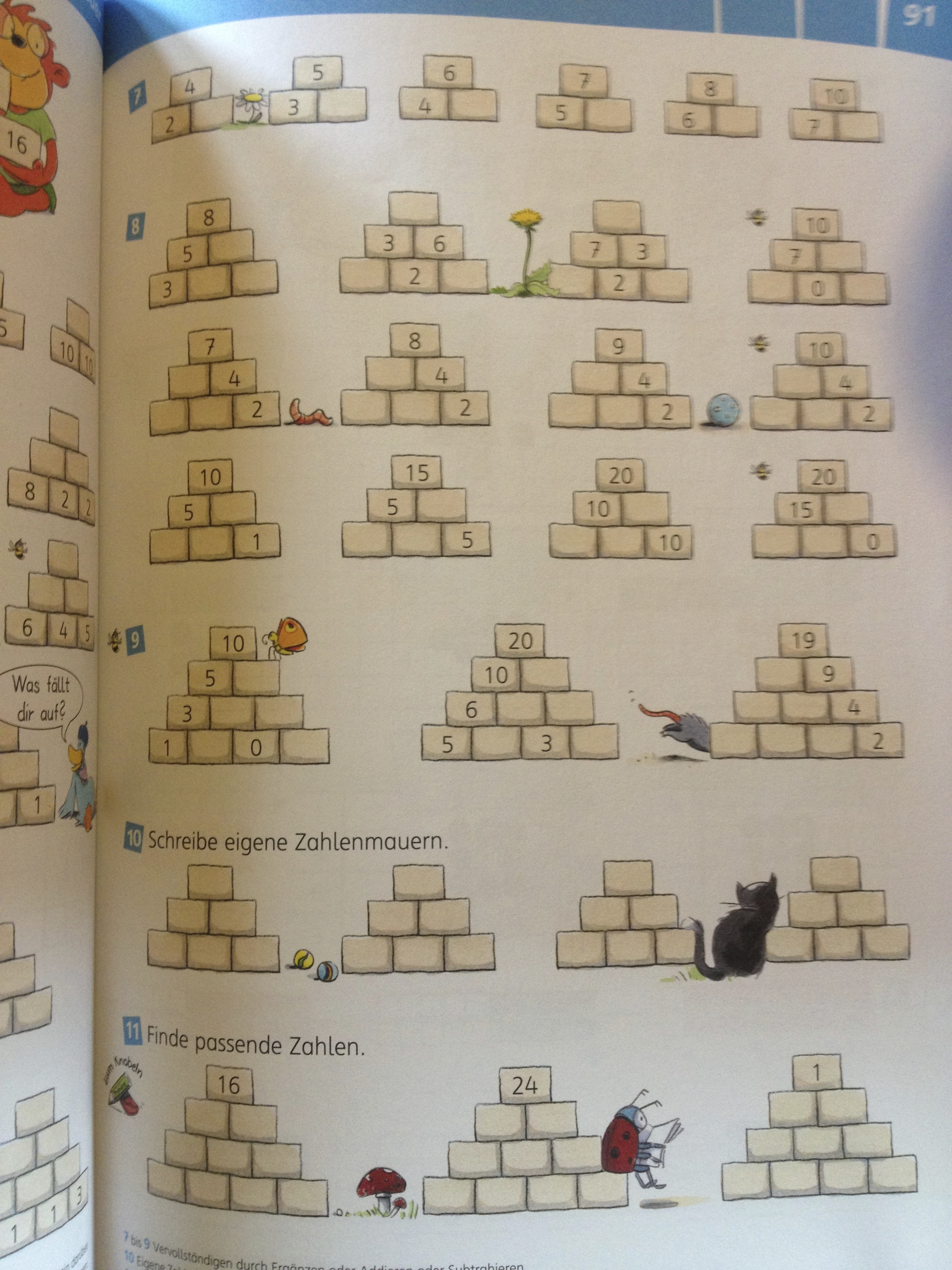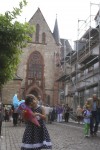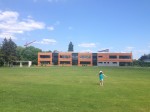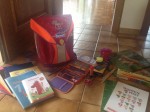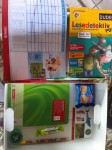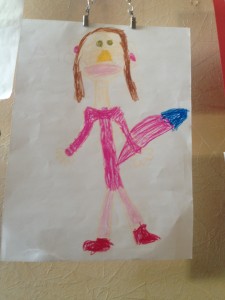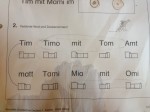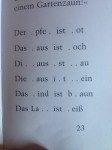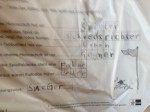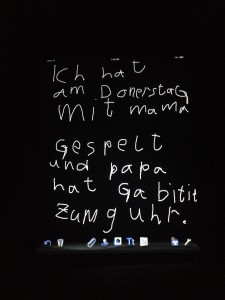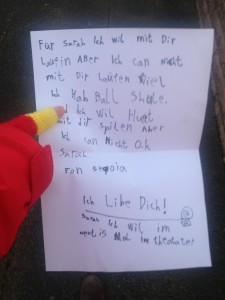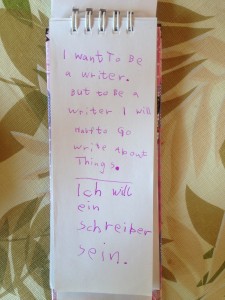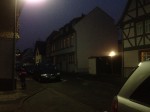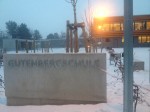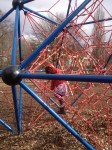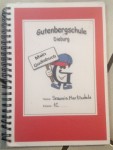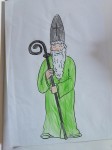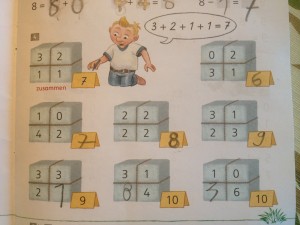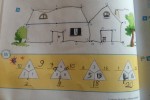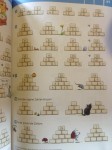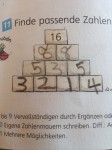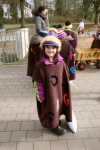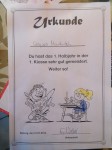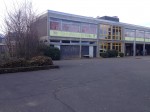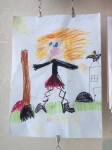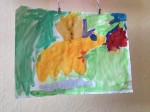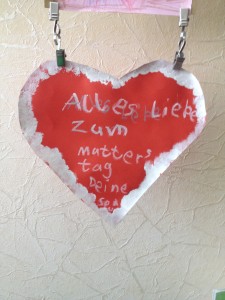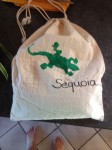Although I am behind on travel posts, I want to take today, Sequoia’s last day of first grade, to look back over the school year in pictures (and a few video clips). This might be interesting not only to family and friends, but also to those curious about German schools–specifically elementary school.
Sequoia’s first day of school began with a blessing at church. Both public elementary schools were in attendance. The priest had to bend down to listen to Sequoia pronounce her name (which, when pronounced by most Germans, is Zay-kvoya).
Sequoia began the year in her regular elementary school…
Her backpack on day one of classes was quite heavy and it included an art box filled with freebies from the local stationery store.
The children’s first art project was to draw a picture of themselves with their Schultüte.
For the following section, it is important to note that German school begins at first grade. There typically is no Kindergarten with a curriculum before the kids enter first grade—freispiel (free play) Kindergartens are like day care. In other words, when I say that something is 2 months into the school year, the children were two months into the introduction of any curriculum whatsoever.
Before school started, Sequoia, who already read English, had begun attempting to read German.
[wpvideo vVpWIlIC]
Five months in, she was reading more fluently.
[wpvideo VofvUtoO]
The German/reading homework included such puzzles as this one in month 2 of introduction to reading. The students, who were simultaneously tracing numbers and practicing writing their letters, had to figure out which words went into which boxes, using box sizes as clues.
Two months later, Sequoia sounded like this…
[wpvideo k7gLjkM9]
(NOTE: this particular video is playing on desktop but not on iphone. I am trying to fix that situation.)
That book involved the kids figuring out the missing letters in order to be able to read the passage. Sequoia got two that I couldn’t get, but then, I didn’t go to German first grade.
Homework included other word puzzles:
After another month, she was reading like this:
[wpvideo 1QbbfCHs]
Meanwhile, I had my own homework every time a notice was sent home! Sequoia eventually began writing in German. At 5 months in, it looked like this:
= Ich hat am Donnerstag mit Mama gespielt und papa hat gearbeitet zum 9 Uhr.
=On Thursday, I played with Mommy, and Daddy worked until 9:00.
After another month, it looked like this:
= Für Sarah, Ich will mit dir laufen aber ich kann nicht mit dir laufen wiel ich habe Ballschule und ich will heute mit dir spielen aber ich kann nicht, Okay? Sarah from Sequoia. Ich liebe dich! Sarah, ich will im nächstes Mal im Theater.
= To Sarah: I want to walk with you but I can’t walk with you because I have Ballschule and I want to play with you today but I can’t, okay? Sarah from Sequoia. I love you! Sarah, I want to go to Theater next time.
(By the end of the year, she had begun at home to write English/German translations)
= I want to be a writer. But to be a writer I will have to go write about things. Ich will ein Schreiber sein.
In the winter, Sequoia walked to school in the dark most days.
Her schedule varied by day, starting at either 0755, 0840, or 0945, and ending between 1130 and 1300. School days lasted from 3 ½ to 4 hours and 15 minutes. Keep that in mind when you consider the children’s progress: half days, starting one year later than American schools. They also have several recesses, a Frühstuck (second breakfast) Pause, and on Mondays, two class periods of Sport (gym class). Clearly, taking breaks is not a bad thing. Not to mention, kids are learning as they play.
The students have a “Gudiebuch”. In the beginning of school it was used primarily as a communication tool for parents and teacher. Sometimes there was quite a bit of communication going on, and at times it pertained to Sequoia’s lack of organization (she is, after all, her mother’s child). Later in the year, the kids began to write their homework assignments in the book.
Sequoia enjoyed her religion class…in public school.
“Wait—what about math?”
It was the main focus, I’d say. Some days Sequoia came home from school to tell me that they’d done math for all three hours. Five weeks into the children’s first introduction to math curriculum, the homework looked like this:
At 4 months, they began to learn that negative numbers existed…
…and began working on these problems:
At 5 months, they were figuring out whether to add or subtract to reach the solution:
At 7 months, they were doing pyramids of increasing difficulty:
Toward the end of the year, they were learning money, the 24-hour clock, greater than/less than, and number lines.
And so by the end of first grade, our local public school has taught the children to read and perform math tasks quite easily to the point children in American schools have reached–in half the number of years and half the schoolday length in their one year. That’s ¼ of the time that Americans have put in by the end of first grade. With a ton of play and Pauses. Although the school year runs longer, during the year there is a two-week fall break, a full three weeks at Christmas, at least one full week’s Easter break, and numerous holidays (including time off for Karneval, because that’s how the Germans roll).
There is little science in first grade. Most of it focuses on nature and animals. Sequoia would come home knowing the names of the flowers in our garden or details about hedgehogs and dinosaurs. Other subjects in first grade include music, art, and English. In first grade the introduction to English is very basic, but it is a regular part of the curriculum.
Sequoia stayed an extra period for extracurricular activities twice a week: chorus on Mondays and Blockflöte (the recorder) on Wednesdays. Flash was not thrilled.
[wpvideo QW70GPbR]
In April, there was a spring concert.
The were quite in unison for first graders. Sequoia is in the front row, third from the left.
[wpvideo SwEnbynH]
We didn’t mind the concert so much because intermission consisted of beer, champagne, and soft pretzels.
In February, the kids marched in the Kinderfasnachtsumzug (the children’s Karneval parade) wearing homemade costumes.
Halfway through the year, kids received “good job” certificates.
Unfortunately, the three-year-old school had not done as good a job at maintaining its plumbing and heating, so the kids had to relocate to the old Gutenbergshule.
During the year, the children went on two official field trips, both times to the theater to see a play. This is what our local schoolbus looks like:
After the first play, the Kleine Hexe (the Small Witch), the kids drew the witch with pastels:
They also painted in art class,
including Mother’s Day cards…
Since Sequoia has unicycles in Sport class, we bought her one and she later began a unicycle class at the local gym.
Other early summer events: a sports day similar to field day, a school World Cup Tournament, and a small dumpster fire in the adjoining schoolyard.
During project week, the kids walked in the woods and picked up crap, then stuck it all in shoeboxes with holes in them. Then they–and we parents–had to reach into the “feel boxes” and identify the contents. The kids also made a few crafts that week, such as this house-shoe bag. After all, they have to change into house shoes to enter the classroom. I actually volunteered, helping them paint these (and practicing my kid German that day!).
And finally, we come to today, the last day of school. Flash woke Sequoia, who slept on her beanbag last night because first graders don’t need chiropractors, and then she got dressed for her last day of first grade!
First graders get “partners” who help the kids get used to the school. They play with their partners all year round in the schoolyard. The first graders made their partners another type of bag to thank them.
The last day consisted of, among other things, singing church songs. There really is not the kind of separation of Church and State to which Americans are accustomed.
She came home with a report. Not a report card–they don’t issue report cards or grades for the first couple years. It is a letter describing Sequoia’s strengths (reading, math, art, music, English (duh), and figuring things out on her own) and weaknesses (organization, attentiveness, following classroom rules, getting along with some classmates, and controlling her emotions). It would appear that school administration got their hands on one of my school reports, translated it into German, and slapped Sequoia’s name on it.
(For additional information about German elementary school, see my articles for Germany, Ja!: Part One, and Part Two)
